Reptiles ID Guide: Snakes
Indiana is home to more than 30 species of snakes. Four of them are venomous. Of the four,
the copperhead is abundant in the southern part of the State. The other three are classified
State Endangered and therefore protected in Indiana. In particular the cottonmouth,
commonly found south of the Ohio river,
is extremely rare. Only a few, probably displaced specimens have ever been found on the
northern shores of the river.
Snake identification can be difficult not only because often we only catch a glimpse of the
slithering creature, but also because the juveniles of solid-color snakes display patterns
that fade with time. This makes them look completely different from the adult. Also,
great color variations between individuals of the same species may confuse the matter further.
Photos and videos courtesy of Roger Carter, Andrew Hoffman, Jim Horton, Rick Marrs and Todd Pierson.
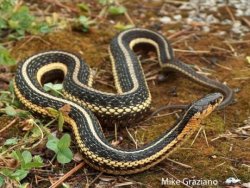 |
Family: Natricidae
Butler's Garter snake
Thamnophis butleris
Size: 15 - 22 inches
Species Status: Endangered
Similar Species: Other Garter snakes, Ribbon snakes
more >> |
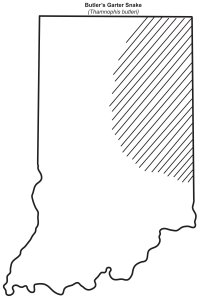 |
Butler's Garter snake
Thamnophis butleris
Size: 15 - 22 inches
Species Status: Endangered
Description: Terrestrial; body slender, dark olive to black, occasionaly checkered; three
straw to bright yellow stripes; belly pale yellow to green/bluish, may present spots
Habitat: Grassland, marshes and water hedges
Diet: Earthworms, leeches
Reproduction: Live bearing - 5 to 20 babies are born in Ausust/September
Similar Species: Other Garter snakes, Ribbon snakes
<< less
|
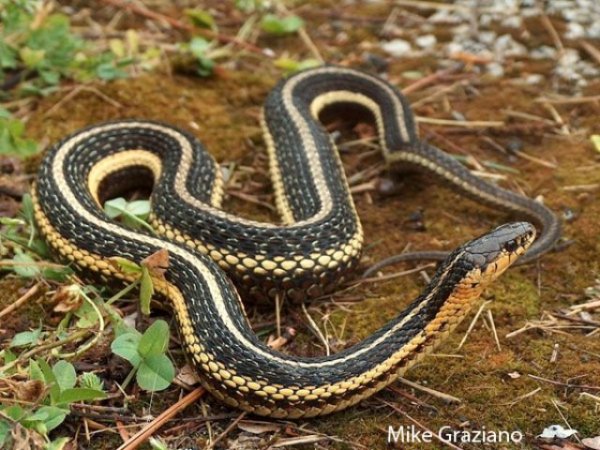 |
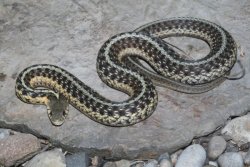 |
Family: Natricidae
Eastern Garter snake
Thamnophis sirtalis
Size: 18 - 36 inches
Species Status: Common
Similar Species: Other Garter snakes, Ribbon snakes
more >> |
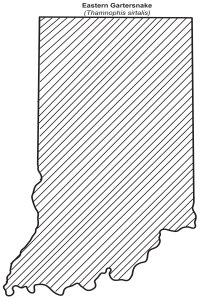 |
Eastern Garter snake
Thamnophis sirtalis
Size: 18 - 36 inches
Species Status: Common
Description: Terrestrial; body slender, cream to olive, occasionaly checkered; three usually
contrasting stripes; belly pale yellow to green/bluish, may present spots
Habitat: Commonly found statewide, it prefers grassland, marshes and water hedges
Diet: Earthworms, frogs and toads, salamanders, small fish
Reproduction: Live bearing - up to 50 babies are born between July and September
Similar Species: Other Garter snakes, Ribbon snakes
Videos:
Eastern Garter snake [size 4.075 MB - 00:00:23]
<< less
|
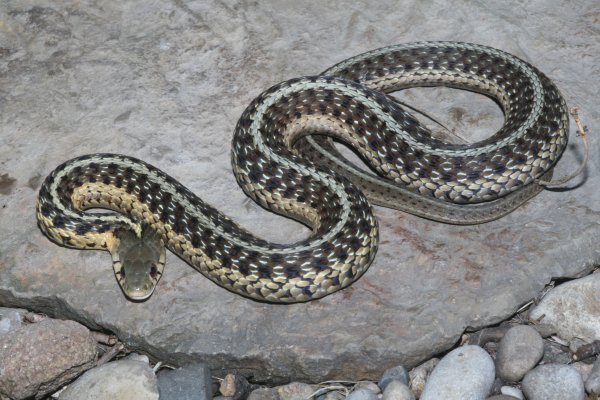 |
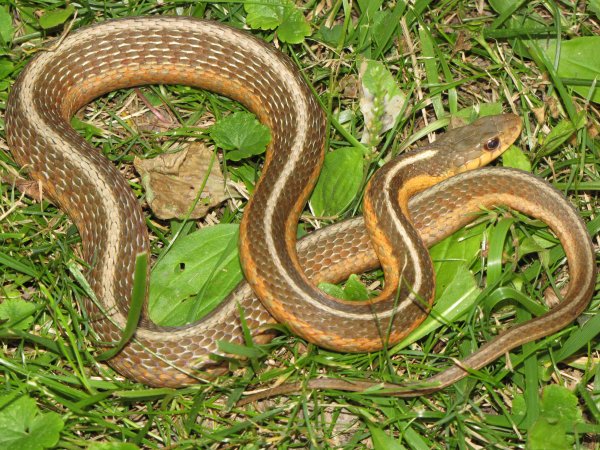 |
 |
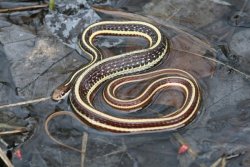 |
Family: Natricidae
Eastern Ribbon snake
Thamnophis sauritus
Size: 18 - 36 inches
Species Status: Common
Similar Species: Western Ribbon snake, Garter snakes
more >> |
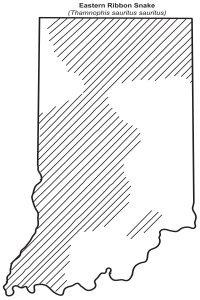 |
Eastern Ribbon snake
Thamnophis sauritus
Size: 18 - 36 inches
Species Status: Common
Description: Terrestrial; body very slender, dark brown to black, occasionaly checkered; three
contrasting stripes; belly pale yellow to green/bluish, may present spots; white to yellow bar
in front of the eye
Habitat: Marshes and water hedges
Diet: Frogs and salamanders
Reproduction: Live bearing - 4 to 12 babies are born in July/August
Similar Species: Western Ribbon snake, Garter snakes
<< less
|
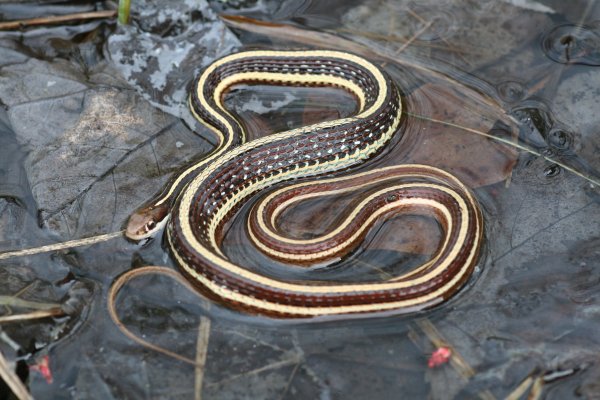 |
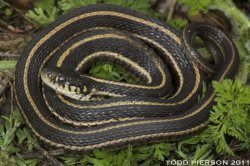 |
Family: Natricidae
Plains Garter snake
Thamnophis radix
Size: less than 20 inches
Species Status: Uncommon
Similar Species: Other Garter snakes, Ribbon snakes
more >> |
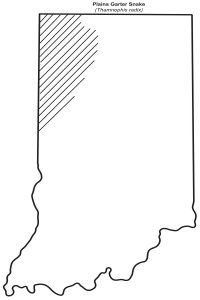 |
Plains Garter snake
Thamnophis radix
Size: less than 20 inches
Species Status: Uncommon
Description: Terrestrial; very similar to the Eastern Garter snake; smaller, darker
body color, very bright dorsal stripe; lateral stripes bordered by rows of black dots;
belly whitish to pale yellow, with lateral black spots
Habitat: Open prairies
Diet: Earthworms
Reproduction: Live bearing - 6 to 40 babies are born in late August
Similar Species: Other Garter snakes, Ribbon snakes
<< less
|
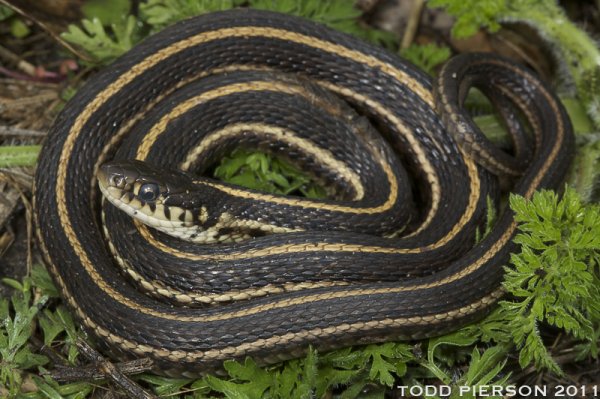 |
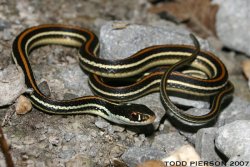 |
Family: Natricidae
Western Ribbon snake
Thamnophis proximus
Size: 20 to 30 inches
Species Status: Uncommon - species of special concern
Similar Species: Eastern Ribbon snake, Garter snakes
more >> |
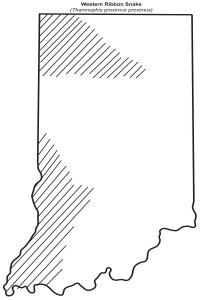 |
Western Ribbon snake
Thamnophis proximus
Size: 20 to 30 inches
Species Status: Uncommon - species of special concern
Description: Terrestrial; very similar to the Eastern Ribbon snake; very thin, blackish
body color, orange/yellowt dorsal stripe; lateral stripes pale yellow/greenish;
light colored bar in front of the eye
Habitat: Sandy, dry water edges
Diet: Amphibians, small fish
Reproduction: Live bearing - up to 20 babies are born in July/August
Similar Species: Eastern Ribbon snake, Garter snakes,
<< less
|
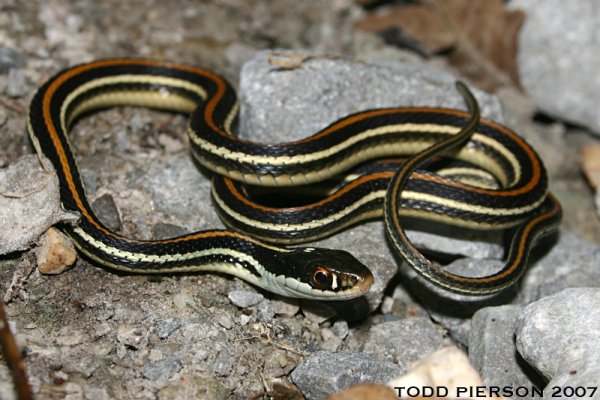 |
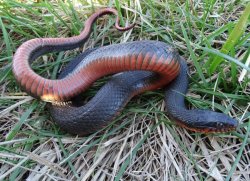 |
Family: Natricidae
Copperbelly Water snake
Nerodia erythrogaster neglecta
Size: 40 - 50 inches
Species Status: Endangered
Similar Species: Northern Water snake, Racers, Cottonmouth
more >> |
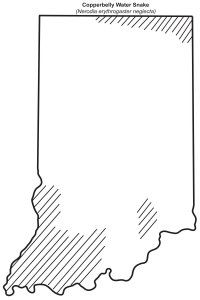 |
Copperbelly Water snake
Nerodia erythrogaster neglecta
Size: 40 - 50 inches
Species Status: Endangered
Description: Aquatic; body dark brown/black;
belly orange/red, in young snakes the reddish belly color flames up to the sides,
producing a pattern similar to that of adult Banded Water snakes
Habitat: Wetlands, water edges
Diet: Amphibians, fish
Reproduction: Live bearing - up to 40 babies are born in September/October
Similar Species: Northern Water snake, Racers, Cottonmouth
<< less
|
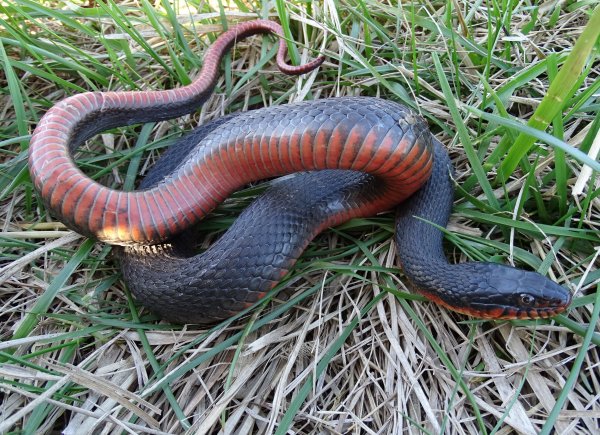 |
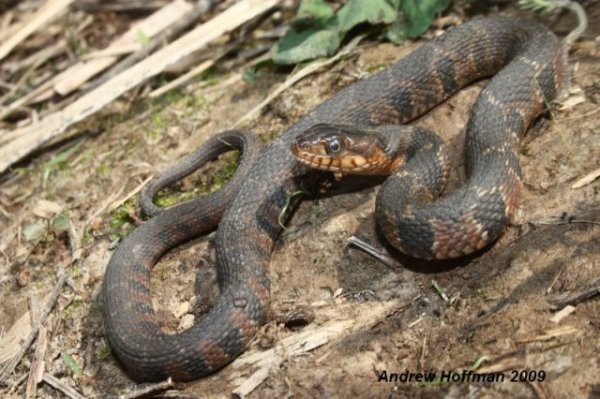 |
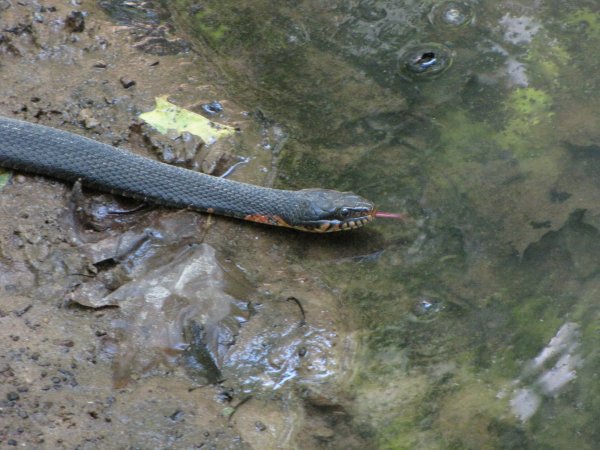 |
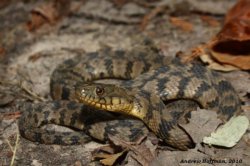 |
Family: Natricidae
Diamondback Water snake
Nerodia rhombifera
Size: 40 - 50 inches
Species Status: Locally abundant
Similar Species: Northern Water snake, Copperbelly, Cottonmouth
more >> |
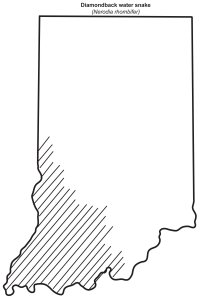 |
Diamondback Water snake
Nerodia rhombifera
Size: 40 - 50 inches
Species Status: Locally abundant
Description: Aquatic; heavy body, tan to brown with dark chain pattern on its back;
belly cream with dark marks
Habitat: Shallow lakes, ponds
Diet: Fish, amphibians
Reproduction: Live bearing - up to 30 babies are born in September/October
Similar Species: Northern Water snake, Copperbelly, Cottonmouth
<< less
|
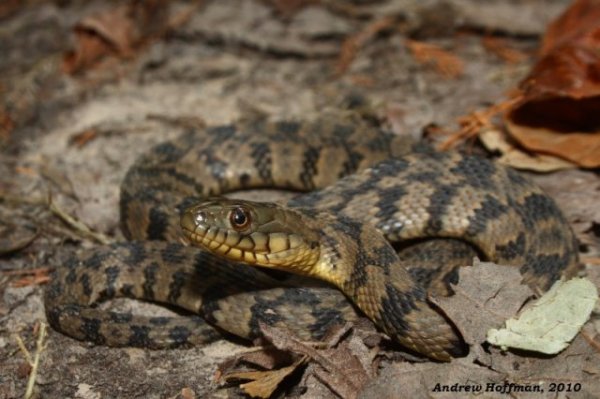 |
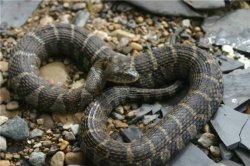 |
Family: Natricidae
Northern Banded Water snake
Nerodia sipedon
Size: 25 - 40 inches
Species Status: Common
Similar Species: Midland Water snake, Copperbelly, Cottonmouth
more >> |
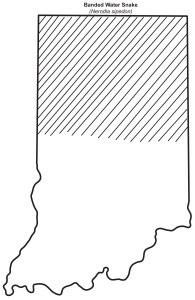 |
Northern Banded Water snake
Nerodia sipedon
Size: 25 - 40 inches
Species Status: Common
Description: Aquatic; heavy body, light gray to tan with dark
wide cross-bands - very similar to the Midland Water snake, which instead displays narrow dark
cross-bands; juveniles show the same patterns, but brighter;
belly solid cream colored
Habitat: Shallow lakes, ponds, creeks, rivers
Diet: Fish, amphibians
Reproduction: Live bearing - up to 50 babies are born in August/September
Similar Species: Midland Water snake, Copperbelly, Cottonmouth
<< less
|
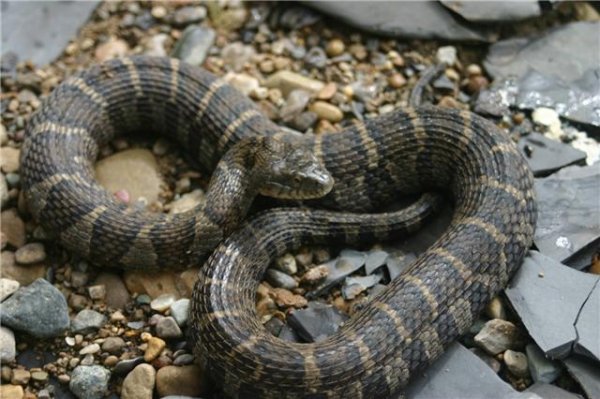 |
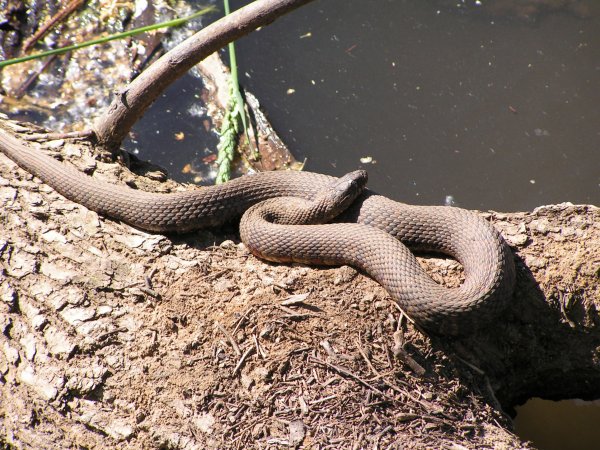 |
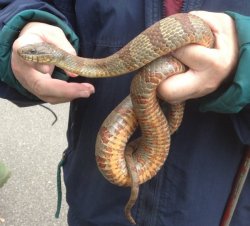 |
Family: Natricidae
Midland Banded Water snake
Nerodia sipedon pleuralis
Size: 25 - 40 inches
Species Status: Common
Similar Species: Northern Water snake, Copperbelly, Cottonmouth
more >> |
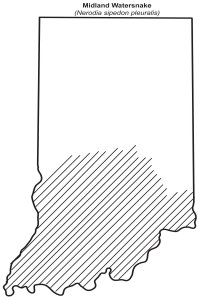 |
Midland Banded Water snake
Nerodia sipedon pleuralis
Size: 25 - 40 inches
Species Status: Common
Description: Aquatic; heavy body, light gray to tan with dark
narrow cross-bands - very similar to the Northern Water snake, which instead displays wider dark
cross-bands; head distincly triangular in older snakes; juveniles show the same patterns, but brighter;
belly cream to reddish with dark marks
Habitat: Shallow lakes, ponds, creeks, rivers
Diet: Fish, amphibians
Reproduction: Live bearing - up to 50 babies are born in August/September
Similar Species: Northern Water snake, Copperbelly, Cottonmouth
<< less
|
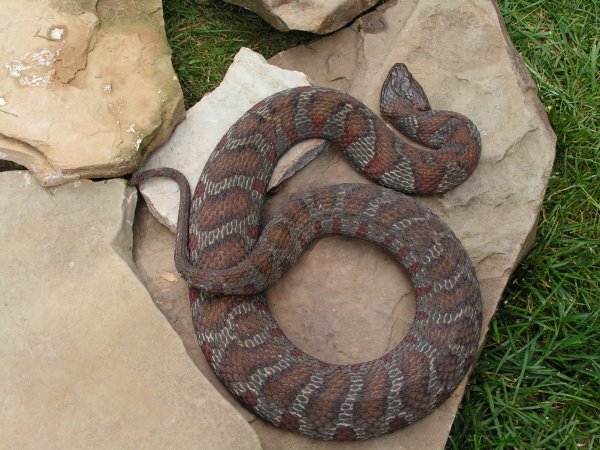 |
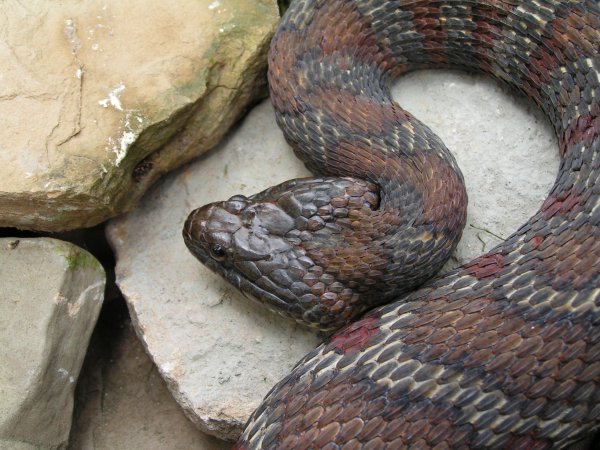 |
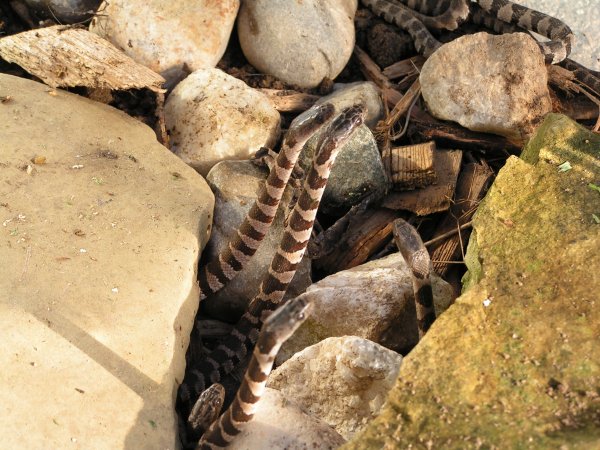 |
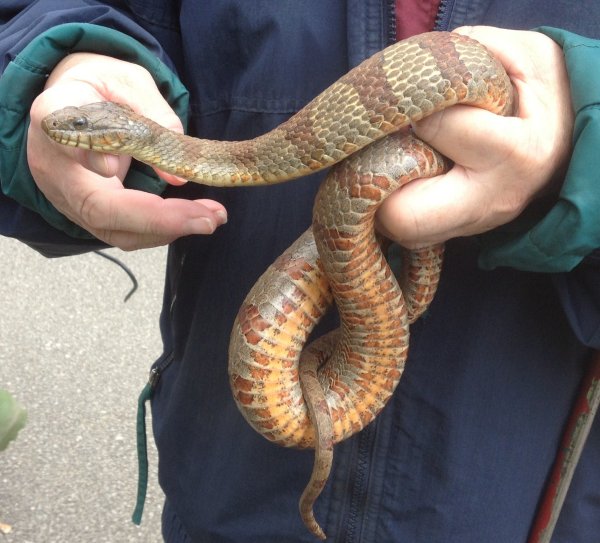 |
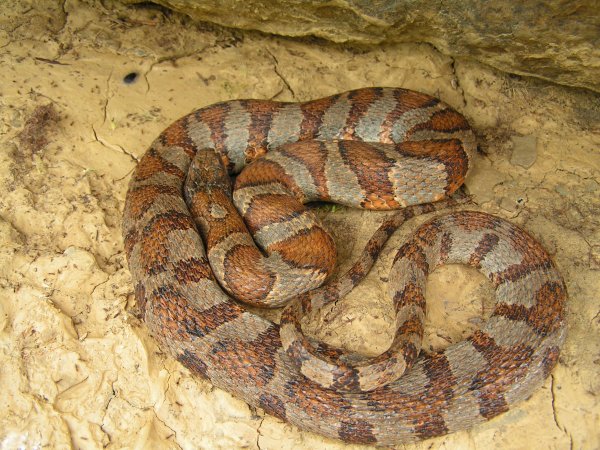 |
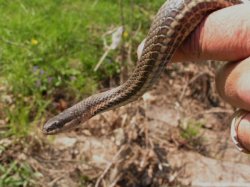 |
Family: Natricidae
Queen snake
Regina septemvittata
Size: 20 - 30 inches
Species Status: Uncommon
Similar Species: Garter snakes
more >> |
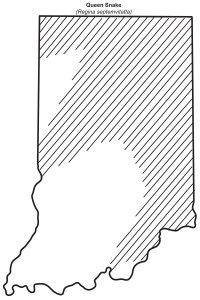 |
Queen snake
Regina septemvittata
Size: 20 - 30 inches
Species Status: Uncommon
Description: Terrestrial; body dark brown to olive with two lateral yellowish stripes;
belly yellow with four reddish longitudinal stripes
Habitat: Wetlands
Diet: Crayfish
Reproduction: Live bearing - up to 18 babies are born in August/September
Similar Species: Garter snakes
<< less
|
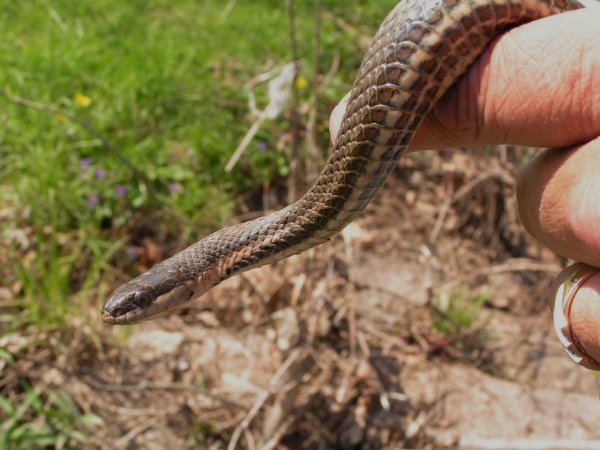 |
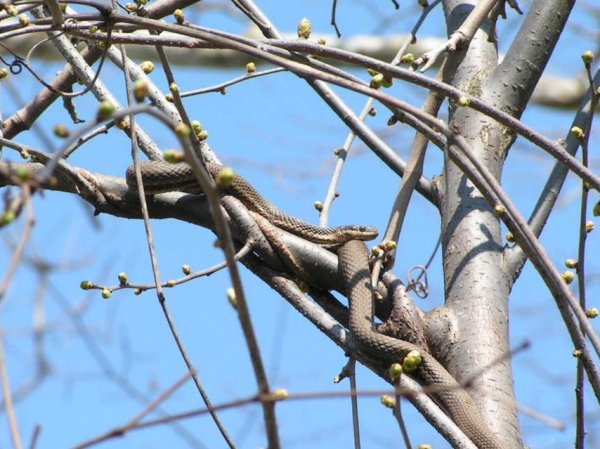 |
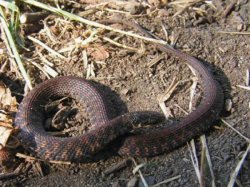 |
Family: Natricidae
Kirtland's snake
Clonophis kirtlandii
Size: 13 - 18 inches
Species Status: Endangered
Similar Species: DeKay's Brown snake, Garter snakes
more >> |
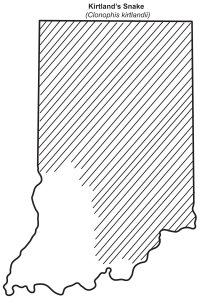 |
Kirtland's snake
Clonophis kirtlandii
Size: 13 - 18 inches
Species Status: Endangered
Description: Terrestrial; body reddish brown with four rows of dark blotches;
belly pink to red with two lines of dark dots
Habitat: Urban areas
Diet: Earthworms
Reproduction: Live bearing - 5 to 12 babies are born in July/August
Similar Species: DeKay's Brown snake, Garter snakes
<< less
|
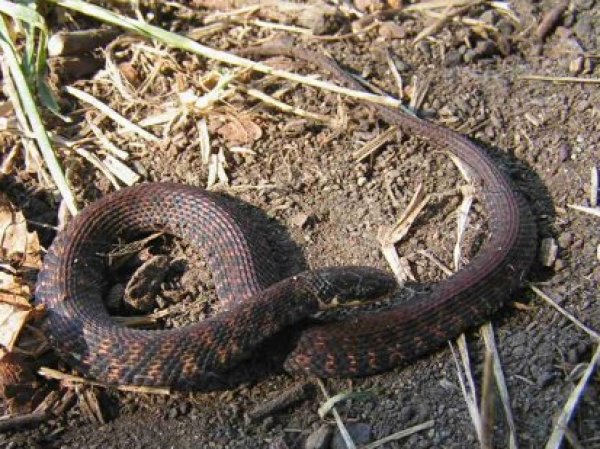 |
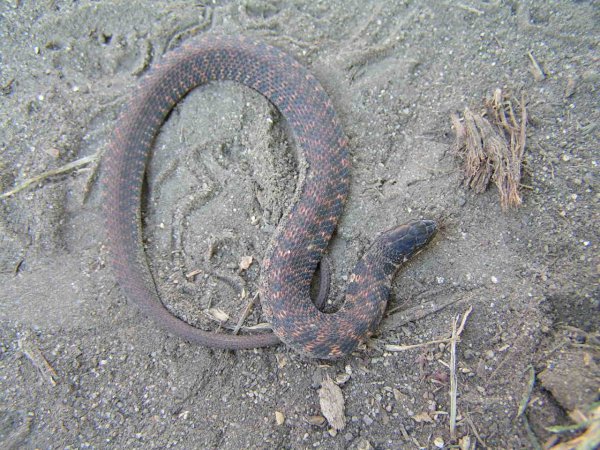 |
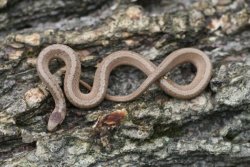 |
Family: Natricidae
DeKay's Brown snake
Storeria dekayi
Size: 10 - 15 inches
Species Status: Abundant
Similar Species: Kirtland's snake, Garter snakes
more >> |
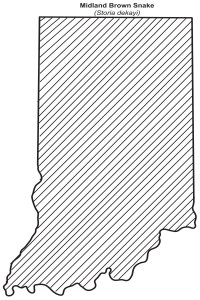 |
DeKay's Brown snake
Storeria dekayi
Size: 10 - 15 inches
Species Status: Abundant
Description: Terrestrial; body graysh brown to chestnut; Lighter strip on back, bordered by
four lines of dots;
belly white to pinkish tan with small dots
Habitat: Open, grassy areas
Diet: Slugs, earthworms
Reproduction: Live bearing - 7 to 15 babies are born in June/September
Similar Species: Kirtland's snake, Garter snakes
<< less
|
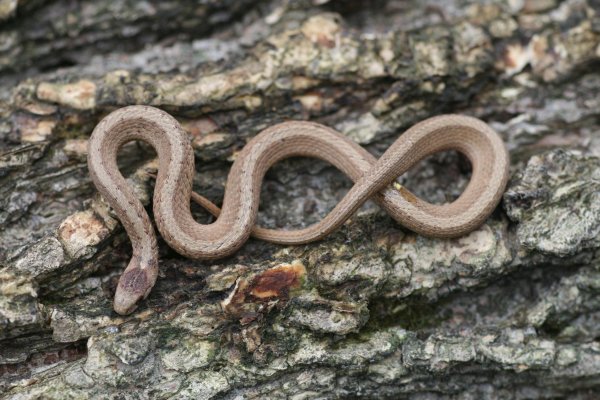 |
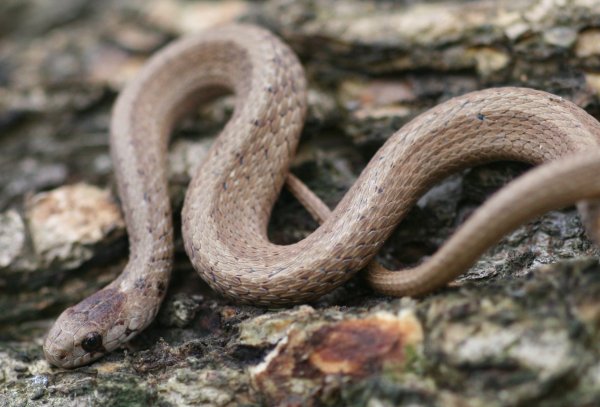 |
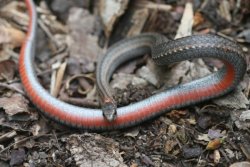 |
Family: Natricidae
Red-bellied snake
Storeria occipitomaculata
Size: 7 - 10 inches
Species Status: Uncommon
Similar Species: Brown snake
more >> |
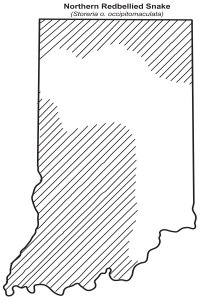 |
Red-bellied snake
Storeria occipitomaculata
Size: 7 - 10 inches
Species Status: Uncommon
Description: Terrestrial; body light brown or gray, light dotted lateral stripes;
head darker with one to three orange spots on the neck;
belly pink to orange
Habitat: Dry, wooded upland
Diet: Slugs, earthworms
Reproduction: Live bearing - babies are born in August
Similar Species: Brown snake
<< less
|
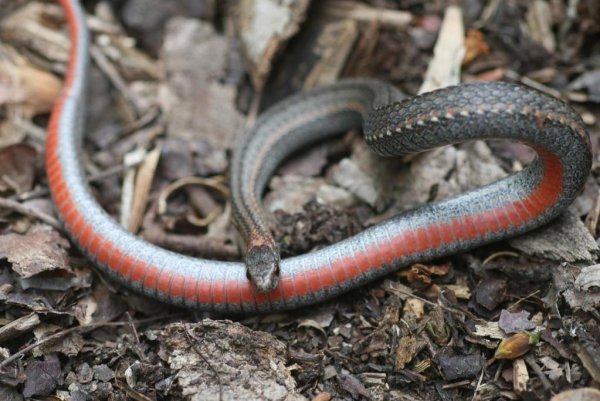 |
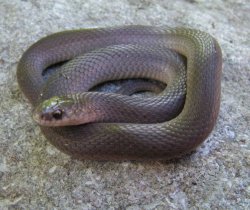 |
Family: Natricidae
Smooth Earth snake
Virginia valeriae
Size: 10 - 12 inches
Species Status: Uncommon
Similar Species: Worm snake, Brown snake, Red-bellied snake
more >> |
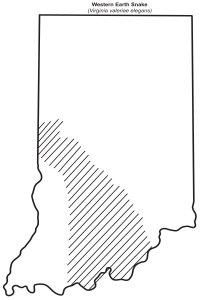 |
Smooth Earth snake
Virginia valeriae
Size: 10 - 12 inches
Species Status: Uncommon
Description: Terrestrial; body brown or gray;
belly cream
Habitat: Rocky, dry, steep slopes
Diet: Earthworms
Reproduction: Live bearing - 3 to 9 babies are born in August
Similar Species: Worm snake, Brown snake, Red-bellied snake
<< less
|
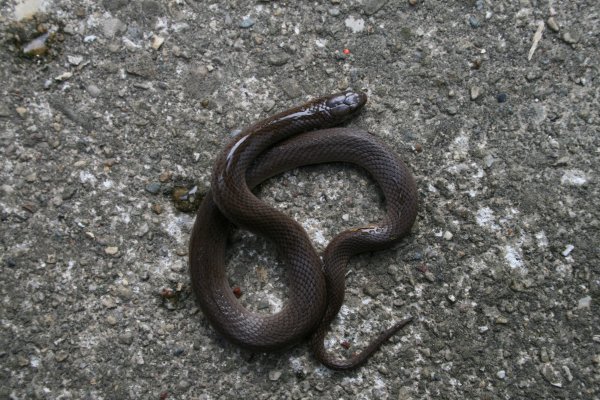 |
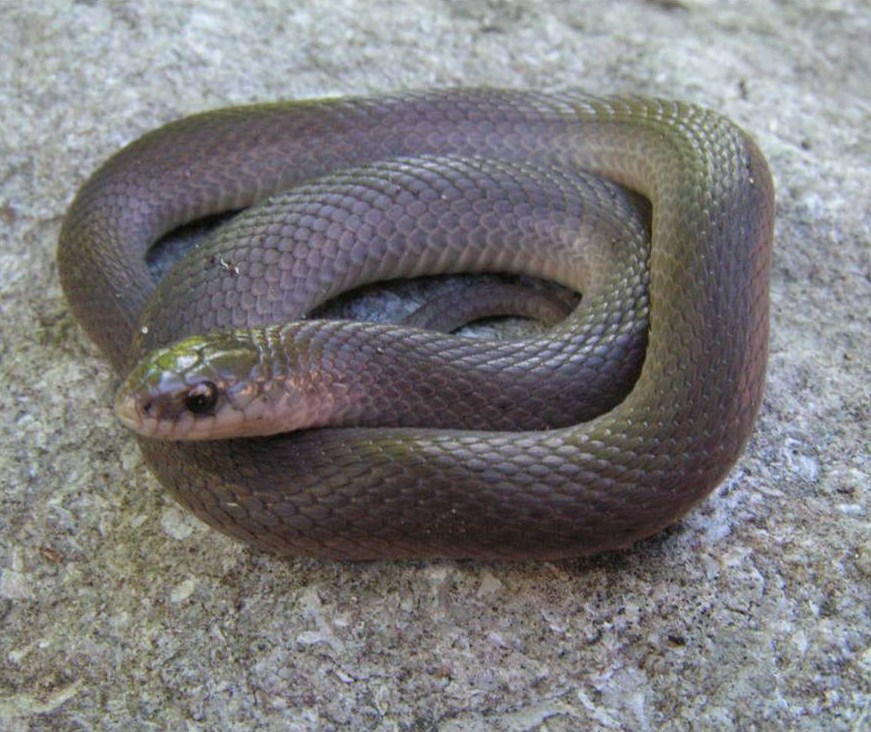 |
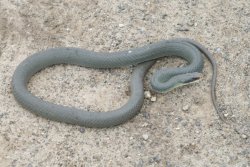 |
Family: Colubridae
Blue Racer
Coluber constrictor foxii
Size: 23 - 50 inches
Species Status: Common
Similar Species: Black Kingsnake, Black Rat snake, Black Racer
more >> |
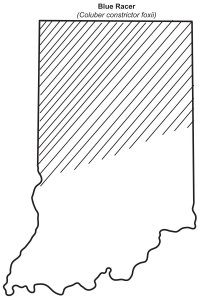 |
Blue Racer
Coluber constrictor foxii
Size: 23 - 50 inches
Species Status: Common
Description: Terrestrial; bluish gray, olive, brownish, lead color;
juveniles light gray, darker toward the tail, dark saddles or crossbands;
belly pale bluish gray
Habitat: Forest edges, abandoned fields
Diet: Insects, small mammals, birds, eggs, amphibians, other snakes
Reproduction: Egg-laying - up to 35 eggs will hatch in July/August
Similar Species: Black Kingsnake, Black Rat snake, Black Racer
<< less
|
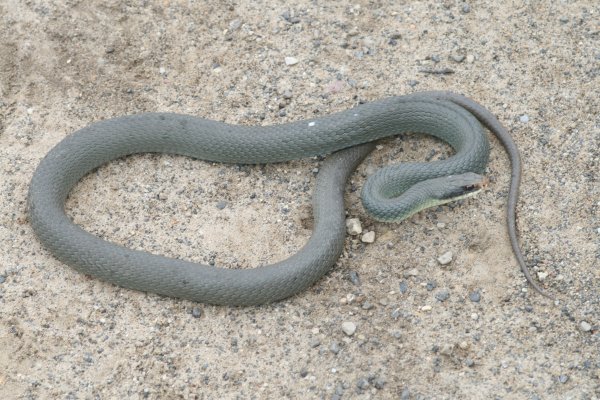 |
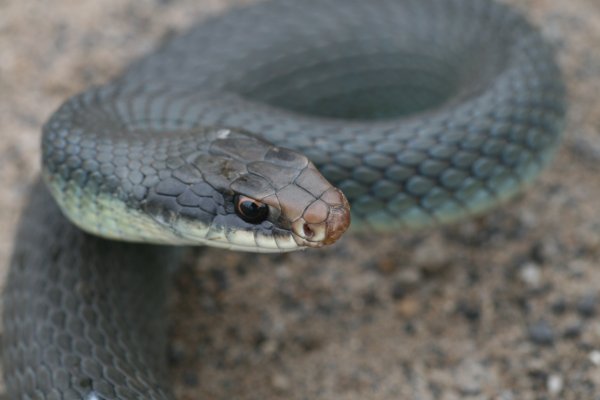 |
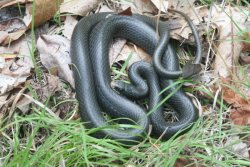 |
Family: Colubridae
Southern Black Racer
Coluber constrictor priapus
Size: 23 - 50 inches
Species Status: Common
Similar Species: Black Kingsnake, Black Rat snake, Blue Racer
more >> |
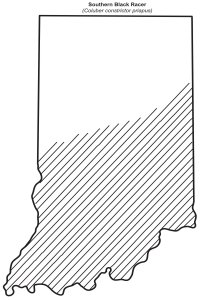 |
Southern Black Racer
Coluber constrictor priapus
Size: 23 - 50 inches
Species Status: Common
Description: Terrestrial; black to dark gray; juveniles display a distinct
pattern; belly slate to bluish gray
Habitat: Forest edges, abandoned fields
Diet: Insects, small mammals, birds, eggs, amphibians, other snakes
Reproduction: Egg-laying - up to 35 eggs will hatch in July/August
Similar Species: Black Kingsnake, Black Rat snake, Blue Racer
<< less
|
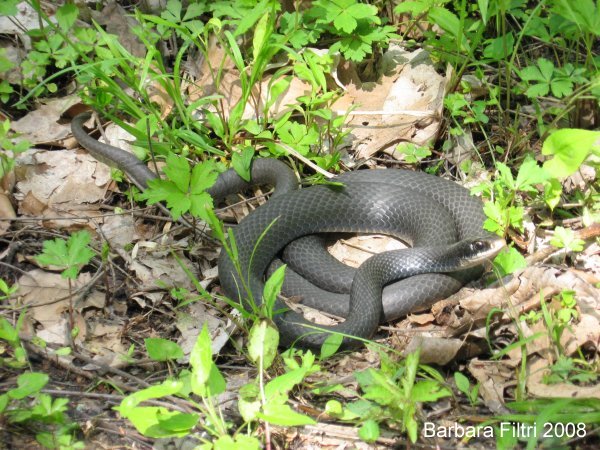 |
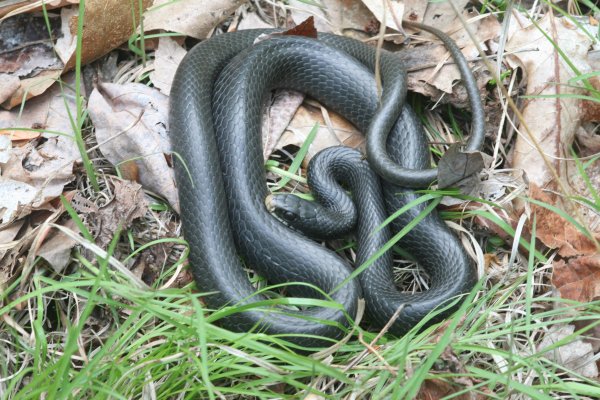 |
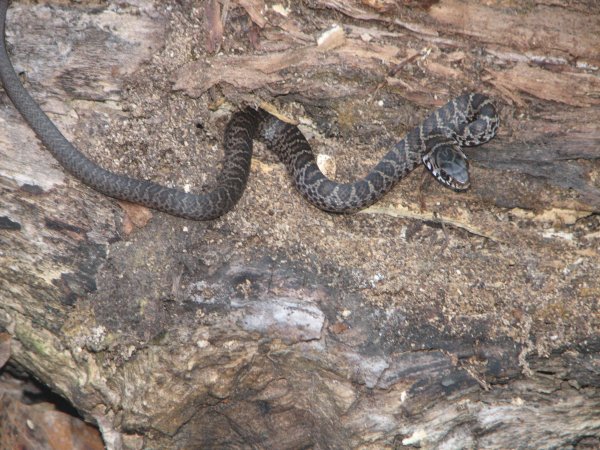 |
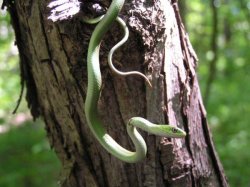 |
Family: Colubridae
Rough Green snake
Opheodrys aestivus
Size: 20 - 30 inches
Species Status: Uncommon
Similar Species: Smooth Green snake
more >> |
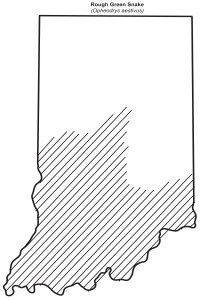 |
Rough Green snake
Opheodrys aestivus
Size: 20 - 30 inches
Species Status: Uncommon
Description: Arboreal; bright green, belly ivory/yellow
Habitat: Dry, open woods, thickets near wetlands and creeks
Diet: Insects, spiders
Reproduction: Egg-laying - 3 to 14 eggs laid in June/July will hatch in August/September
Similar Species: Smooth Green snake
Videos:
Rough Green snake [size 5.621 MB - 00:00:30]
<< less
|
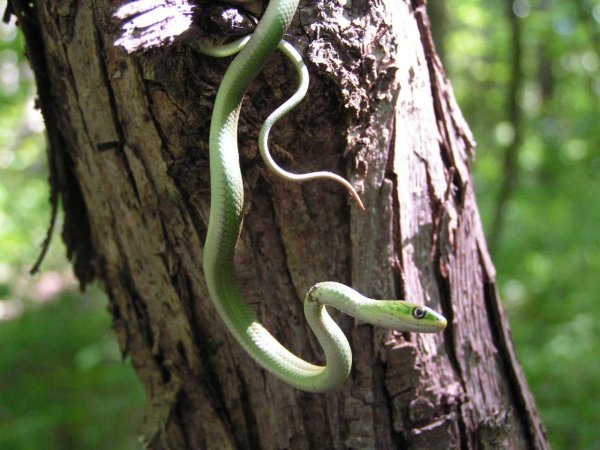 |
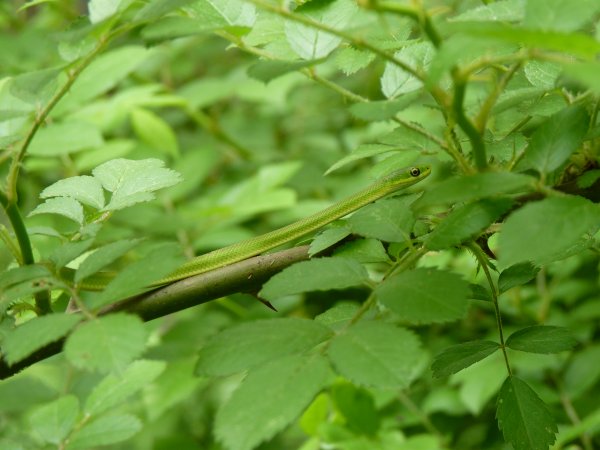 |
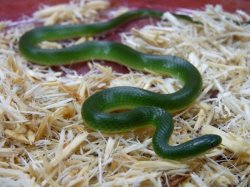 |
Family: Colubridae
Smooth Green snake
Opheodrys vernalis
Size: 15 - 20 inches
Species Status: Endangered
Similar Species: Rough Green snake
more >> |
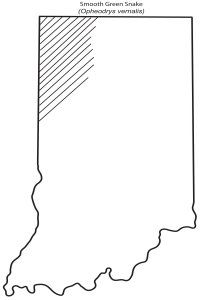 |
Smooth Green snake
Opheodrys vernalis
Size: 15 - 20 inches
Species Status: Endangered
Description: Terrestrial; dark green, belly lighter green/yellowish
Habitat: Sandy woods, sandy prairies
Diet: Insects, spiders
Reproduction: Egg-laying - 5 to 18 eggs laid in June/July will hatch in July/August
Similar Species: Rough Green snake
<< less
|
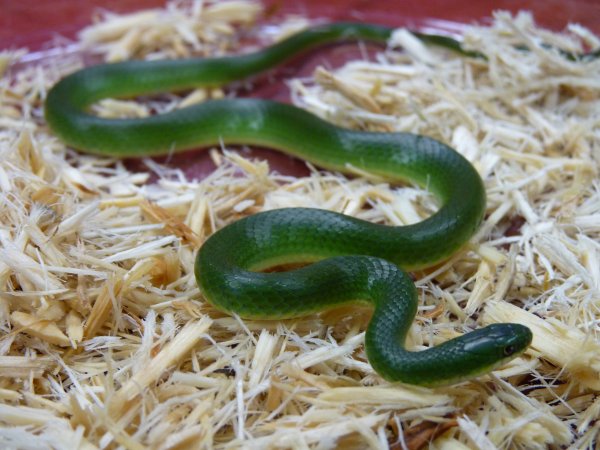 |
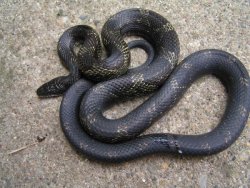 |
Family: Colubridae
Black Rat snake
Pantheropis obsoleta (Elaphe obsoleta obsoleta)
Size: 42 - 72 inches
Species Status: Common
Similar Species: Black Kingsnake, Racers
more >> |
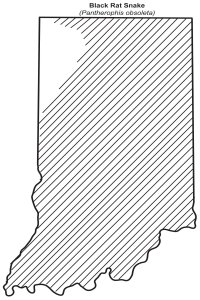 |
Black Rat snake
Pantheropis obsoleta (Elaphe obsoleta obsoleta)
Size: 42 - 72 inches
Species Status: Common
Description: Semi-arboreal; mostly black, retaining traces of the juvenile
pattern; distintly flat belly, grayish with dark checkered pattern
Habitat: Very adaptable, will not be found in densely populated areas and permanent wetlands
Diet: Small rodents, birds, bird eggs
Reproduction: Egg-laying - up to 20 eggs laid in July will hatch in September
Similar Species: Black Kingsnake, Racers
Videos:
Black Rat snake by Jim Horton [size 9.555 MB - 00:00:57]
Black Rat snake eating a (dead) Robin by Rick Marrs [size 18.234 MB - 00:04:15]
<< less
|
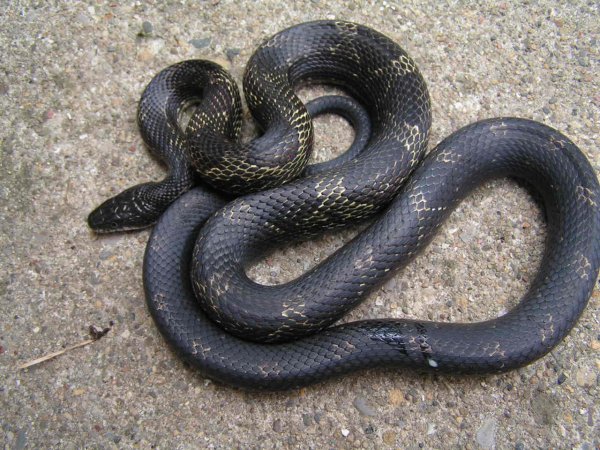 |
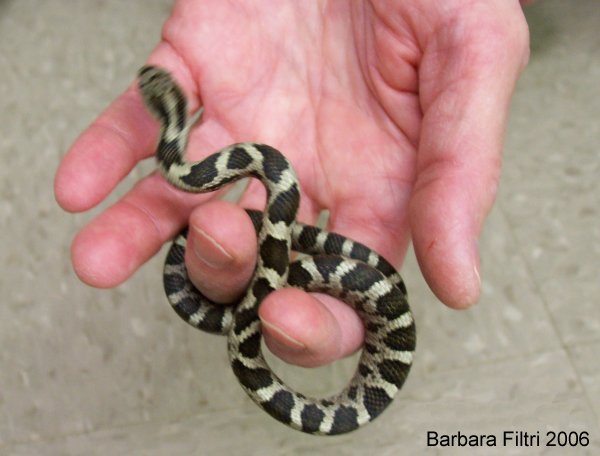 |
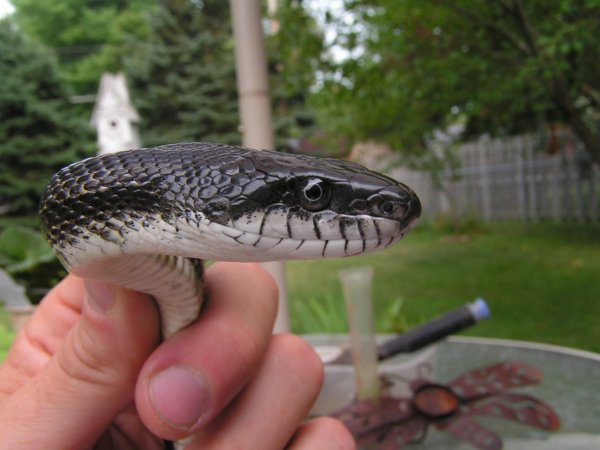 |
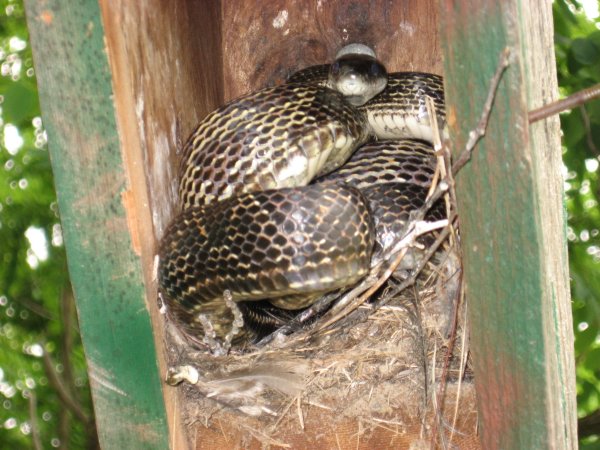 |
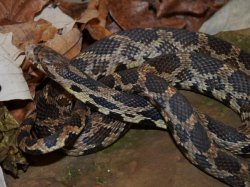 |
Family: Colubridae
Fox snake
Elaphe vulpina vulpina
Size: 40 - 50 inches
Species Status: Uncommon
Similar Species: Bull snake, Hognose snake
more >> |
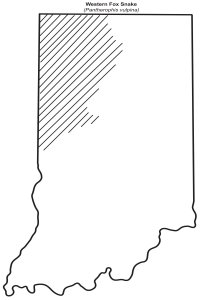 |
Fox snake
Elaphe vulpina vulpina
Size: 40 - 50 inches
Species Status: Uncommon
Description: Terrestrial; body grayish yellow, dark dorsal blotches,
alternating lateral smaller blotches;
juveniles very similar to juvenile Black Rat snakes;
belly cream to straw with dark checkered pattern
Habitat: Wet grassland
Diet: Small rodents
Reproduction: Egg-laying - up to 15 eggs laid in July will hatch in August
Similar Species: Bull snake, Hognose snake
<< less
|
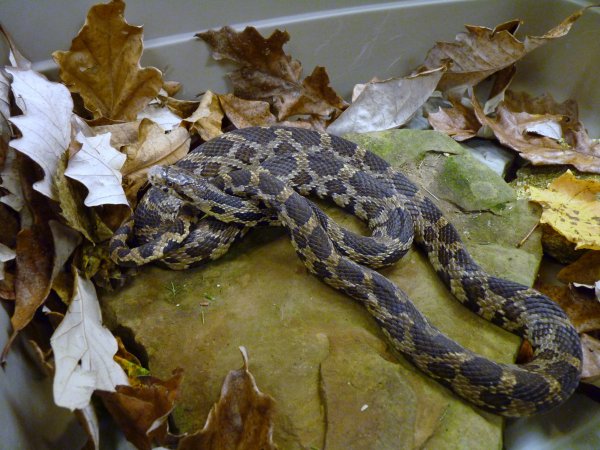 |
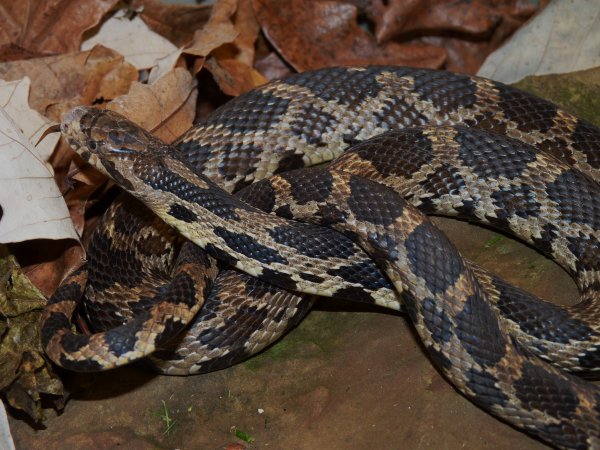 |
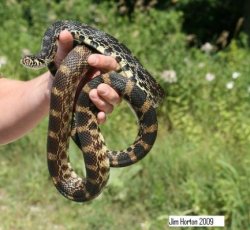 |
Family: Colubridae
Bull snake
Pituophis catenifer sayi
Size: 50 - 72 inches
Species Status: Uncommon
Similar Species: Fox snake, Hognose snake
more >> |
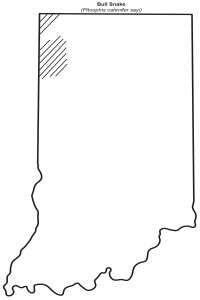 |
Bull snake
Pituophis catenifer sayi
Size: 50 - 72 inches
Species Status: Uncommon
Description: Terrestrial; body pale straw to dark yellow,
dark dorsal blotches, alternating lateral smaller blotches;
belly pale yellow with dark checkered pattern;
the only Indiana snake which actually produces a long and very loud hiss when startled
Habitat: Sandy prairies
Diet: Small mammals, birds, eggs
Reproduction: Egg-laying - over 50 eggs laid in July will hatch in September
Similar Species: Fox snake, Hognose snake
<< less
|
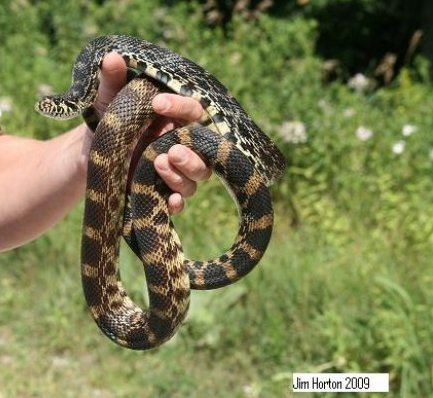 |
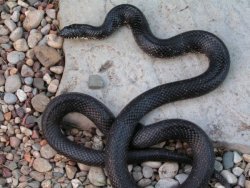 |
Family: Colubridae
Black King snake
Lampropeltis getula nigra
Size: 36 - 48 inches
Species Status: Common
Similar Species: Black Rat snake, Racers
more >> |
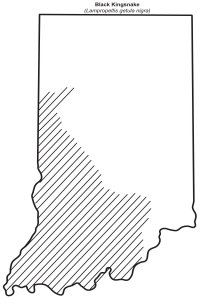 |
Black King snake
Lampropeltis getula nigra
Size: 36 - 48 inches
Species Status: Common
Description: Terrestrial; body black with white or yellow dots, mostly lateral;
belly white to cream, checkered with slate or black
Habitat: Sparse, dry woods, rocky hillsides, abandoned fields and buildings
Diet: Snakes (including venomous), rodents, reptile eggs
Reproduction: Egg-laying - up to 15 eggs laid in July will hatch in September
Similar Species: Black Rat snake, Racers
<< less
|
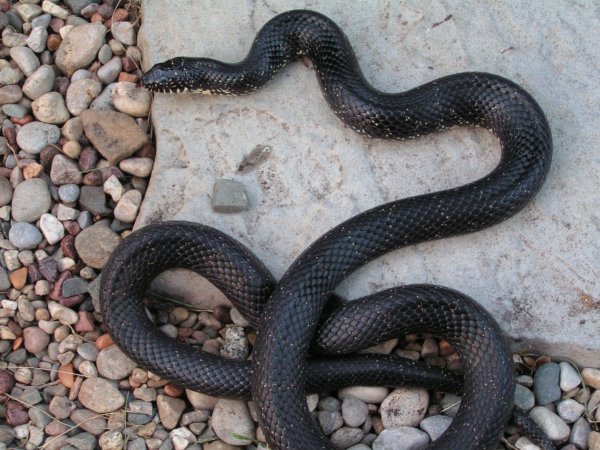 |
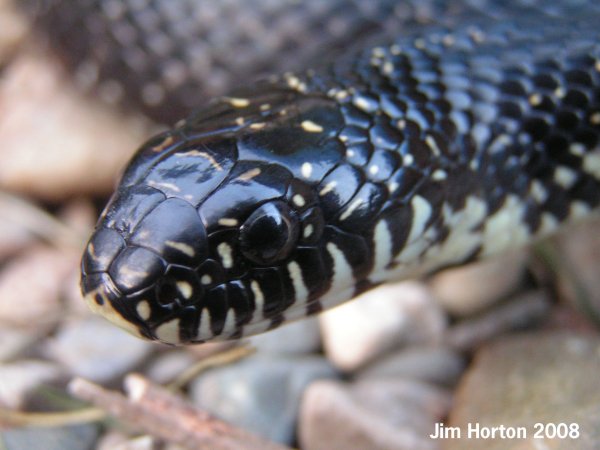 |
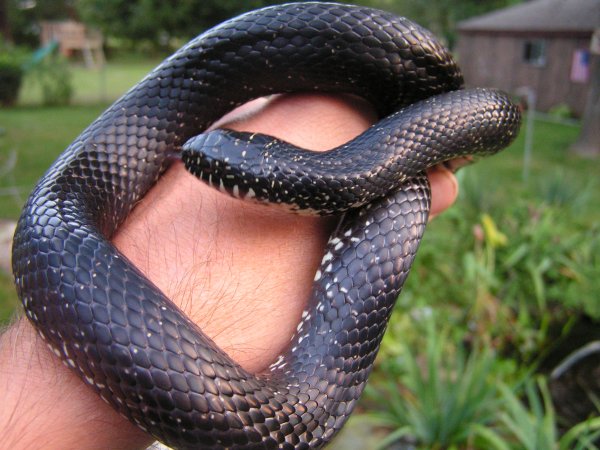 |
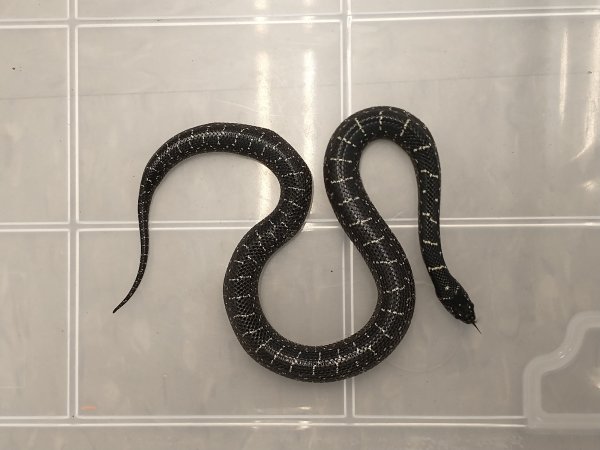 |
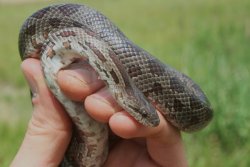 |
Family: Colubridae
Prairie King snake
Lampropeltis calligaster calligaster
Size: 32 - 42 inches
Species Status: Uncommon
Similar Species: Eastern Milk snake
more >> |
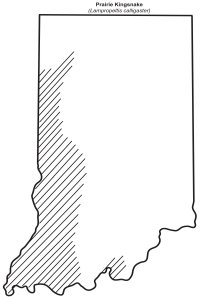 |
Prairie King snake
Lampropeltis calligaster calligaster
Size: 32 - 42 inches
Species Status: Uncommon
Description: Terrestrial; body grayish brown to light tan, with maroon to dark
olive brown dorsal blotches alternating with lateral blotches;
belly cream, checkered with gray
Habitat: Sparse, dry woods, prairies, abandoned fields and buildings
Diet: Small mammals, birds and eggs, amphibians, snakes (including venomous)
Reproduction: Egg-laying - up to 12 eggs laid in June/July will hatch in August
Similar Species: Eastern Milk snake
<< less
|
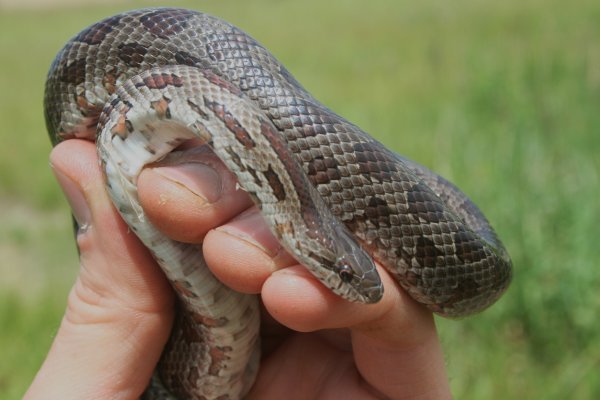 |
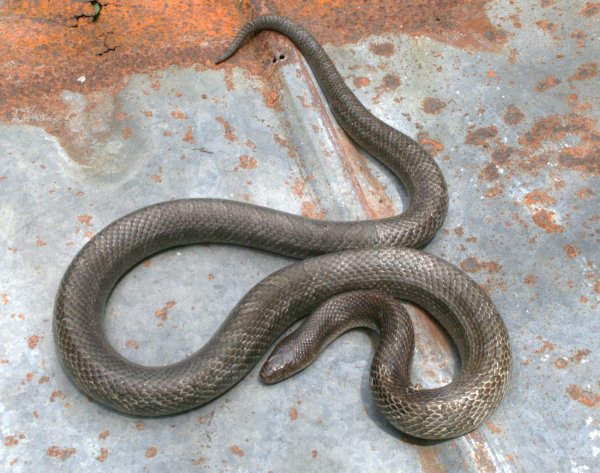 |
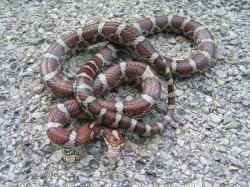 |
Family: Colubridae
Eastern Milk snake
Lampropeltis triangulum triangulum
Size: 24 - 36 inches
Species Status: Common
Similar Species: Prairie King snake
more >> |
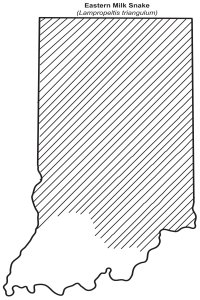 |
Eastern Milk snake
Lampropeltis triangulum triangulum
Size: 24 - 36 inches
Species Status: Common
Description: Terrestrial; body pale gray to light yellow,
with tan,maroon, chestnut or brown dorsal blotches bordered in black
alternating with smaller lateral blotches;
belly white, checkered or speckled with dark slate
Habitat: Wooded upland areas, edges of fields, suburbs
Diet: Small mammals, birds, snakes (including venomous)
Reproduction: Egg-laying - up to 12 eggs laid in June/July will hatch in August/September
Similar Species: Prairie King snake
<< less
|
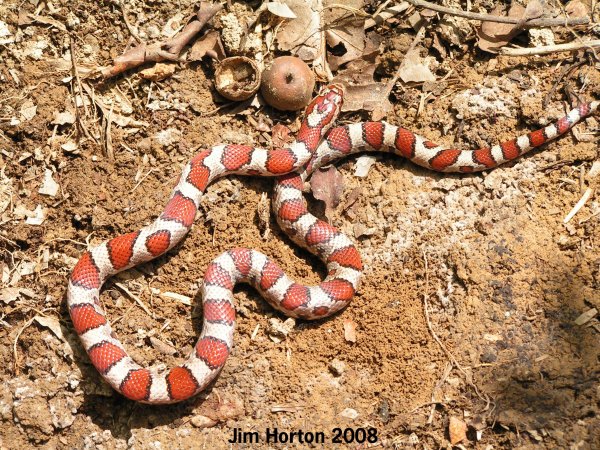 |
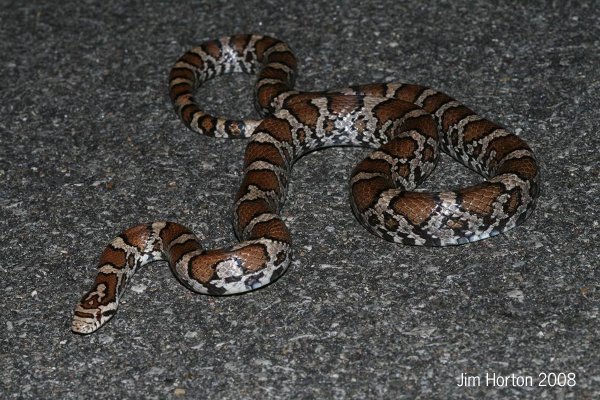 |
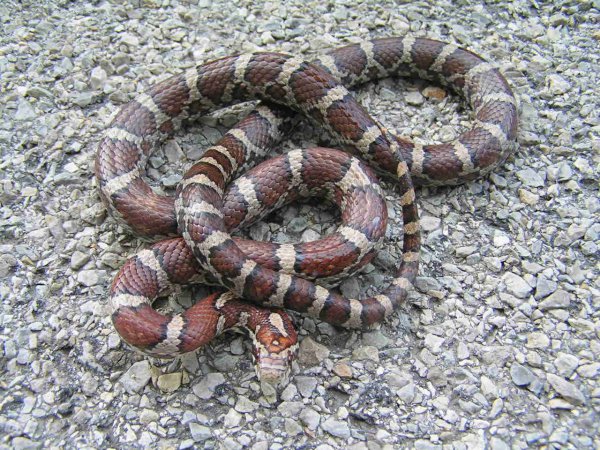 |
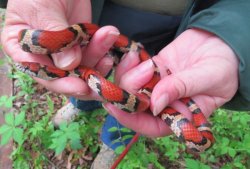 |
Family: Colubridae
Red Milk snake
Lampropeltis triangulum syspila
Size: 24 - 36 inches
Species Status: Uncommon
Similar Species: Scarlet snake
more >> |
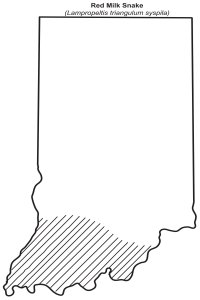 |
Red Milk snake
Lampropeltis triangulum syspila
Size: 24 - 36 inches
Species Status: Uncommon
Description: Terrestrial; body cream to pale gray,
with bright red dorsal blotches alternating with lateral blotches bordered in black;
dorsal blotches much wider than in the Eastern Milk snake,
give the appearance of rings, thus the common name "candy cane snake";
belly white, checkered with black
Habitat: Wooded upland areas, edges of fields, suburbs
Diet: Small mammals, birds, snakes (including venomous)
Reproduction: Egg-laying - up to 12 eggs laid in June/July will hatch in August/September
Similar Species: Scarlet snake
<< less
|
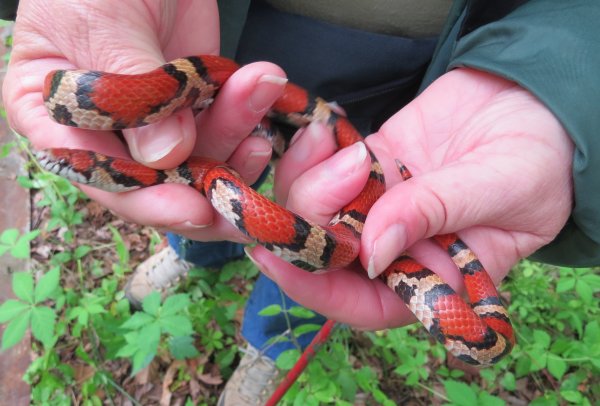 |
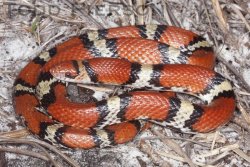 |
Family: Colubridae
Scarlet snake
Cemophora coccinea
Size: 14 - 21 inches
Species Status: Endangered
Similar Species: Red Milk snake
more >> |
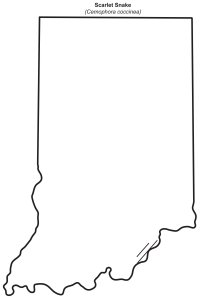 |
Scarlet snake
Cemophora coccinea
Size: 14 - 21 inches
Species Status: Endangered
Description: Terrestrial; body white to cream,
with orange to red wide dorsal blotches bordered in black;
belly white
Habitat: Dry, rocky hillsides
Diet: Lizards, snakes, reptile eggs
Reproduction: Egg-laying - up to 5 eggs laid in July will hatch in August
Similar Species: Red Milk snake
<< less
|
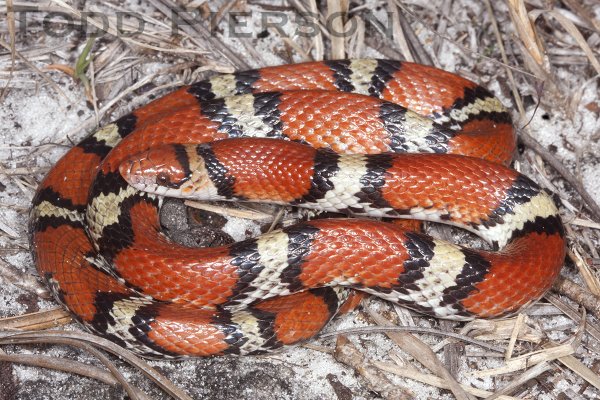 |
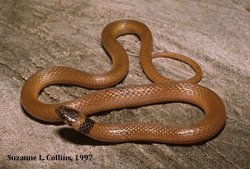 |
Family: Colubridae
Southeastern Crowned snake
Tantilla coronata
Size: 8 - 10 inches
Species Status: Endangered
Similar Species: Ringneck snake
more >> |
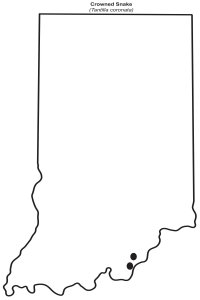 |
Southeastern Crowned snake
Tantilla coronata
Size: 8 - 10 inches
Species Status: Endangered
Description: Terrestrial; body light brown, dark head, dark ring on the neck;
belly white with pinkish glare
Habitat: Southeastern snake; a few specimens have been found near New Albany;
found on dry, rocky slopes
Diet: Insects, spiders
Reproduction: Egg-laying - up to 3 eggs laid in May/June will hatch in July
Similar Species: Ringneck snake
<< less
|
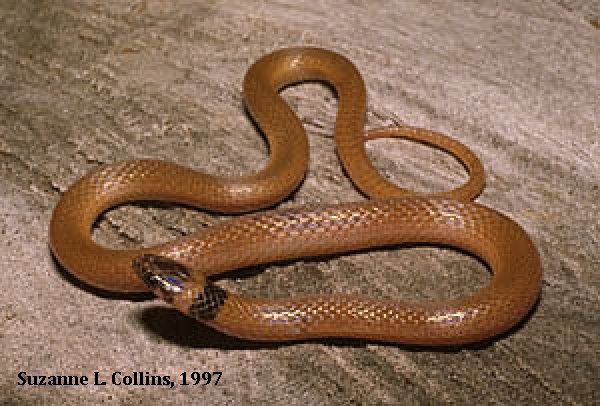 |
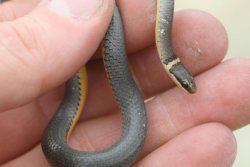 |
Family: Dipsadidae
Ringneck snake
Diadophis punctatus
Size: 12 - 15 inches
Species Status: Common
Similar Species: Southeastern Crowned snake
more >> |
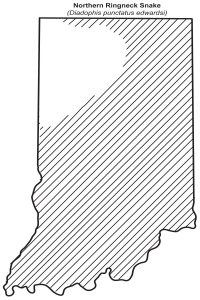 |
Ringneck snake
Diadophis punctatus
Size: 12 - 15 inches
Species Status: Common
Description: Terrestrial; body dark to light gray, cream to orange ring on the neck;
belly cream to orange; bodies of newborn are black and become lighter in color as they age
Habitat: Shady, moist rocky slopes
Diet: Amphibians, earthworms, other small snakes
Reproduction: Egg-laying - up to 6 eggs will hatch in August/September
Similar Species: Southeastern Crowned snake
<< less
|
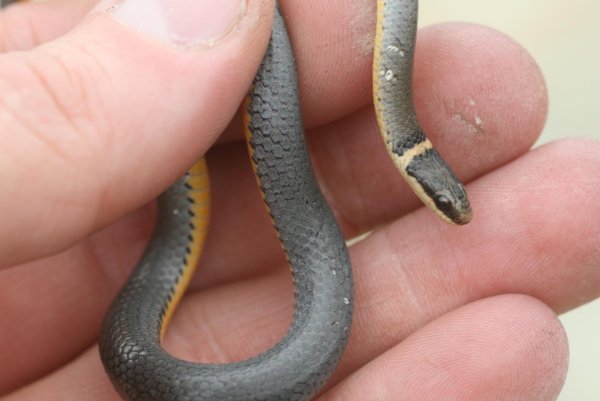 |
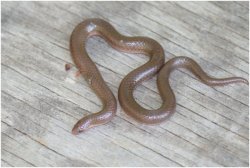 |
Family: Dipsadidae
Midwest Worm snake
Carphophis amoenus
Size: 9 - 12 inches
Species Status: Unknown
Similar Species: None - may be mistaken for an earthworm
more >> |
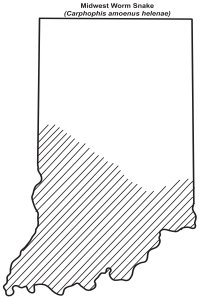 |
Midwest Worm snake
Carphophis amoenus
Size: 9 - 12 inches
Species Status: Unknown
Description: Terrestrial; body golden brown to chestnut;
belly pink
Habitat: Moist rocky slopes
Diet: Earthworms
Reproduction: Egg-laying - up to 5 eggs laid in July will hatch in September
Similar Species: None - may be mistaken for an earthworm
<< less
|
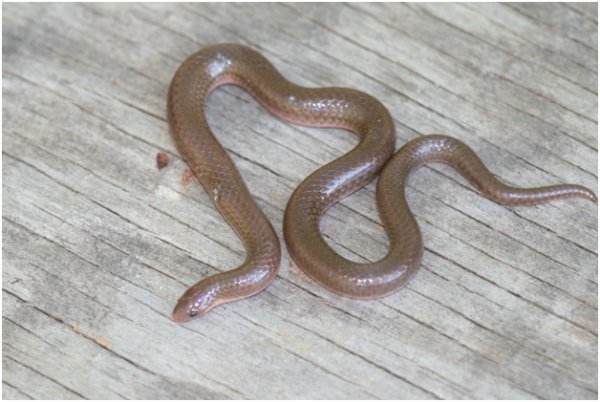 |
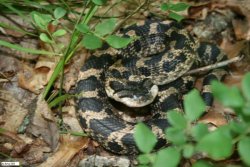 |
Family: Xenodontidae
Eastern Hognose snake
Heterodon platirhinos
Size:22 - 32 inches
Species Status: Uncommon
Similar Species: Fox snake, Bull snake
more >> |
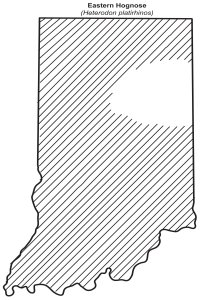 |
Eastern Hognose snake
Heterodon platirhinos
Size:22 - 32 inches
Species Status: Uncommon
Description: Terrestrial; body color and patterns extremely variable;
melanistic (all black) snakes quite common;
belly gray; sharply upturned snout; easily recognized by behaviour:
when disturbed will hiss loudly, play "cobra" either upright or flat on ground, or play "dead"
Habitat: Dry, open spaces near water
Diet: Toads, other amphibians
Reproduction: Egg-laying - up to 30 eggs laid in June/July will hatch in September
Similar Species: Fox snake, Bull snake
<< less
|
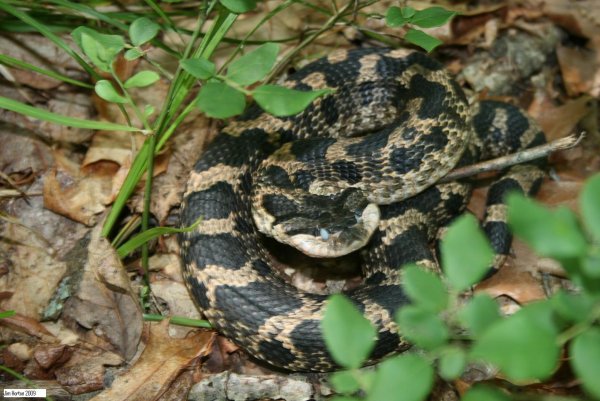 |
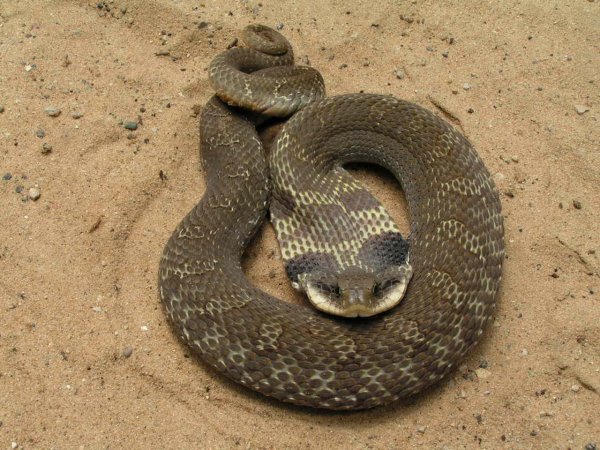 |
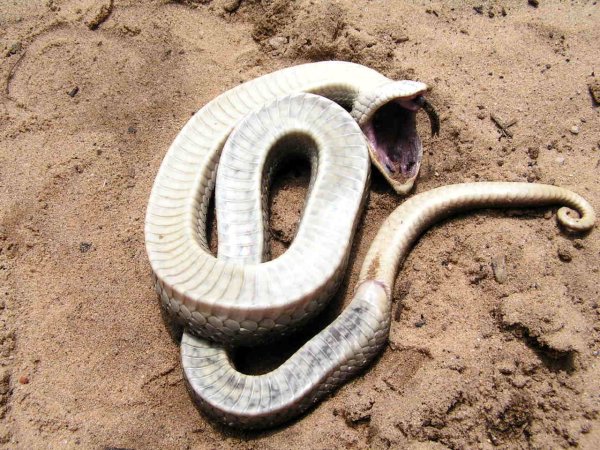 |
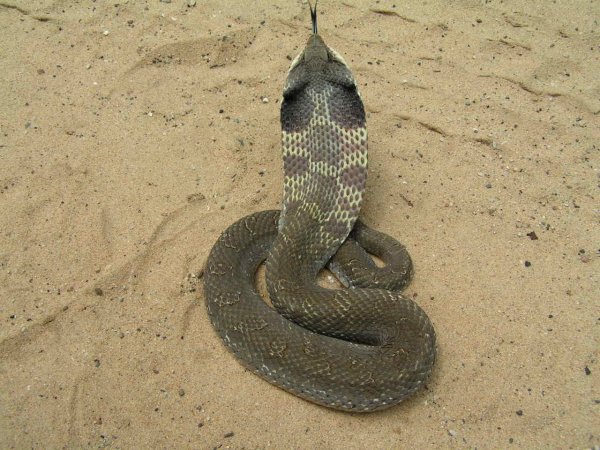 |
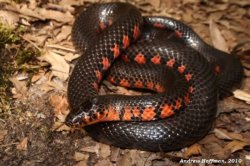 |
Family: Xenodontidae
Mud snake
Farancia abacura
Size:40 - 54 inches
Species Status: Extirpated
Similar Species: Copperbelly water snake
more >> |
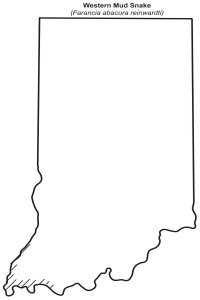 |
<Mud snake
Farancia abacura
Size:40 - 54 inches
Species Status: Extirpated
Description: Aquatic; body black with low lateral red blotches;
belly bright red;
Habitat: Cypress swamps and marshes
Diet: Salamanders, fish
Reproduction: Egg-laying - up to 12 eggs laid in July will hatch in September;
the only North American snake that broods its eggs
Similar Species: Copperbelly water snake
<< less
|
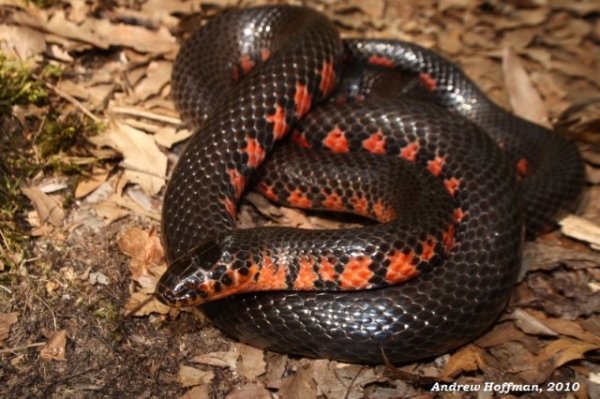 |
|
--- VENOMOUS ---
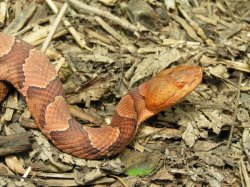 |
Family: Crotalidae
Copperhead
Agkistrodon contortrix
Size: 24 - 36 inches
Species Status: Unknown
Similar Species: Non-venomous Water snakes
more >> |
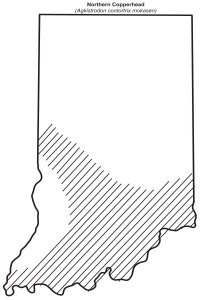 |
|
--- VENOMOUS ---
Copperhead
Agkistrodon contortrix
Size: 24 - 36 inches
Species Status: Unknown
Description: Terrestrial; stout body, cream/brown hourglass pattern,
northern specimens display dark spots in the light blotches; belly pinkish
with dark spots, darker tail; triangular head, copper-colored, heat-sensing
pits, elliptical pupils; juveniles display yellow/green tail
Habitat: Dry, rocky terrain, forested areas
Diet: Small rodents and insects, especially cicadas, occasionally amphibians
Reproduction: Live bearing - up to 12 babies are born in August/September
Similar Species: Non-venomous Water snakes
Videos:
Spy-cam ~ Copperhead in a burrow by Roger Carter [size 4.143 MB - 00:00:39]
Copperhead by Rick Marrs [size 4.836 MB - 00:01:06]
<< less
|
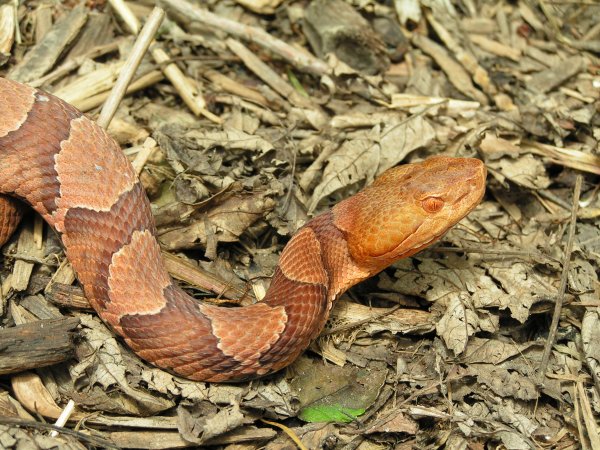 |
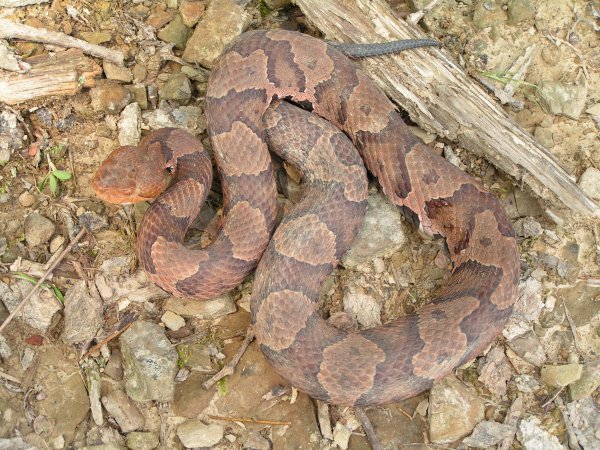 |
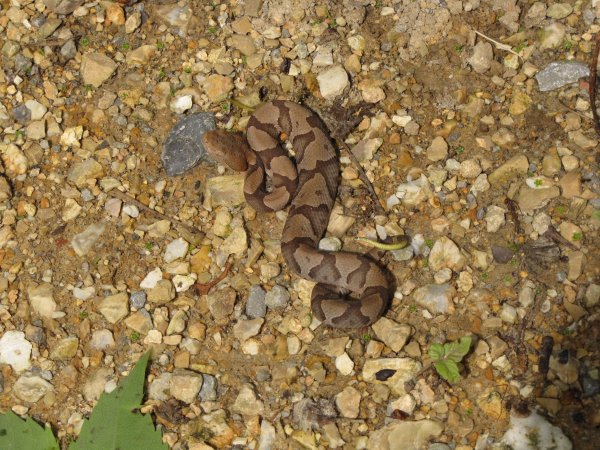 |
|
--- VENOMOUS ---
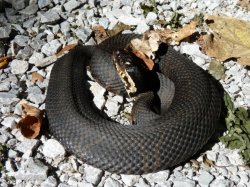 |
Family: Crotalidae
Cottonmouth (Water mocassin)
Agkistrodon piscivorus leucostoma
Size: 30 - 42 inches
Species Status: Endangered
Similar Species: Non-venomous Water snakes
more >> |
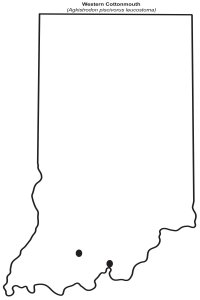 |
|
--- VENOMOUS ---
Cottonmouth (Water mocassin)
Agkistrodon piscivorus leucostoma
Size: 30 - 42 inches
Species Status: Endangered
Description: Aquatic; heavy body, black or dark brown, occasionally retaining faint traces of the juvenile
pattern; belly cream with dark, paired lateral spots, black tail; triangular head, heat-sensing
pits, elliptical pupils; juveniles display brown/cream pattern and yellow/green tail
Habitat: Only few specimens have ever been found in extreme Southern Indiana
Diet: Mostly fish, occasionally amphibians, small mammals and other snakes
Reproduction: Live bearing - 5 to 15 babies are born in August/September
Similar Species: Non-venomous Water snakes
Videos:
Cottonmouth at the base of the bluff [size 23.504 MB - 00:02:13]
Baby Cottonmouth rattling his tail [size 5.112 MB - 00:01:02]
Cottonmouth in the water [size 2.619 MB - 00:00:14]
Cottonmouth leaving the water [size 1.980 MB - 00:00:11]
<< less
|
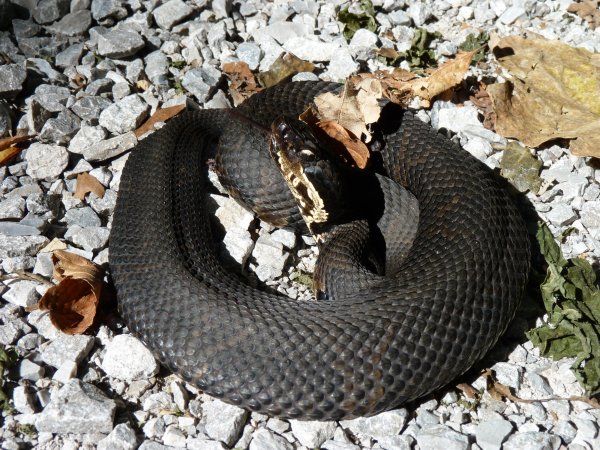 |
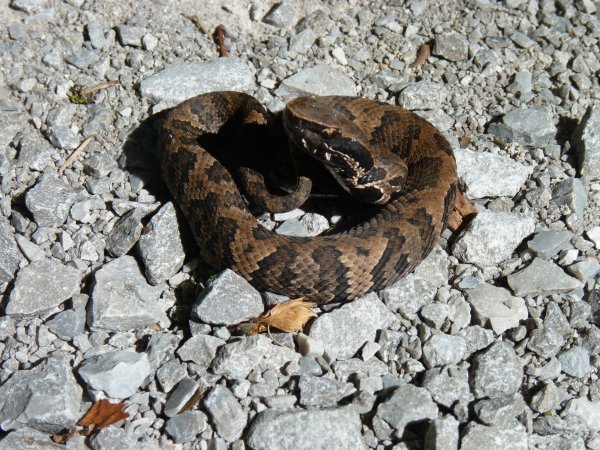 |
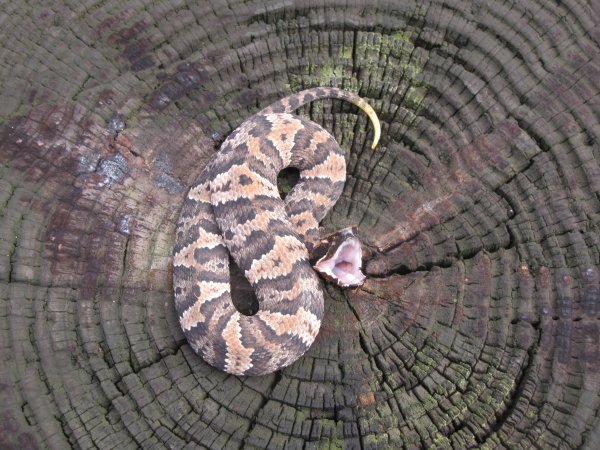 |
|
--- VENOMOUS ---
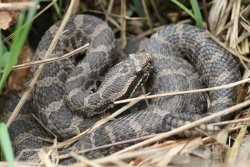 |
Family: Crotalidae
Massasauga
Sistrurus catenatus
Size: 20 - 25 inches
Species Status: Endangered
Similar Species: Timber Rattlesnake, Fox snake
more >> |
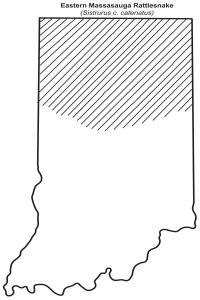 |
|
--- VENOMOUS ---
Massasauga
Sistrurus catenatus
Size: 20 - 25 inches
Species Status: Endangered
Description: Terrestrial; moderately heavy body, light gray to grayish brown or dull yellow;
dark gray dorsal blotches, three rows of alternating lateral small blotches;
belly black laterally flecked white; moderate size head, heat-sensing
pits, elliptical pupils; the tail ends with rattles
Habitat: Grassland, marshes, edges of water, prairies and fields
Diet: Small mammals and other snakes
Reproduction: Live bearing - 7 to 15 babies are born in September
Similar Species: Timber Rattlesnake, Fox snake
<< less
|
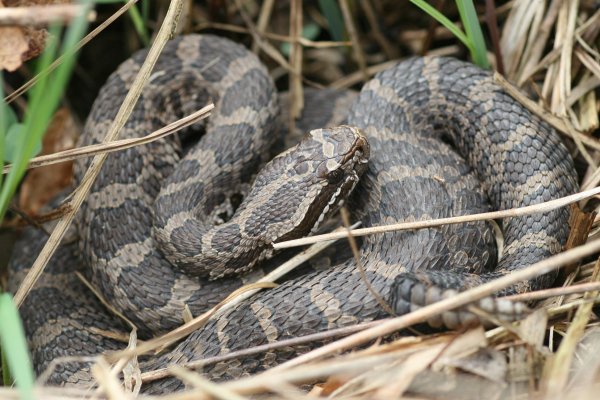 |
|
--- VENOMOUS ---
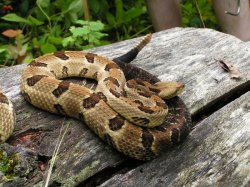 |
Family: Crotalidae
Timber Rattlesnake
Crotalus horridus
Size: 48 - 72 inches
Species Status: Endangered
Similar Species: Massasauga
more >> |
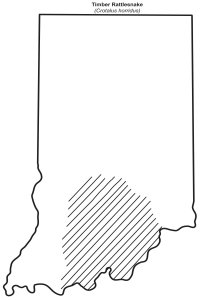 |
|
--- VENOMOUS ---
Timber Rattlesnake
Crotalus horridus
Size: 48 - 72 inches
Species Status: Endangered
Description: Terrestrial; heavy body, yellow to gray or light brown;
black crossbands or blunt chevrons bordered with cream;
tan to rusty vertebral band;
belly white to cream with dark pigmentation heavier toward the tail;
triangular head, heat-sensing pits, elliptical pupils; the tail ends with rattles;
babies are grayish and much less bright than adults
Habitat: High, dry ridges
Diet: Squirrels, chipmunks and other small mammals, birds
Reproduction: Live bearing - up to 15 babies are born in September/October
Similar Species: Massasauga
Videos:
Timber Rattlesnake by Rick Marrs [size 4.689 MB - 00:01:11]
<< less
|
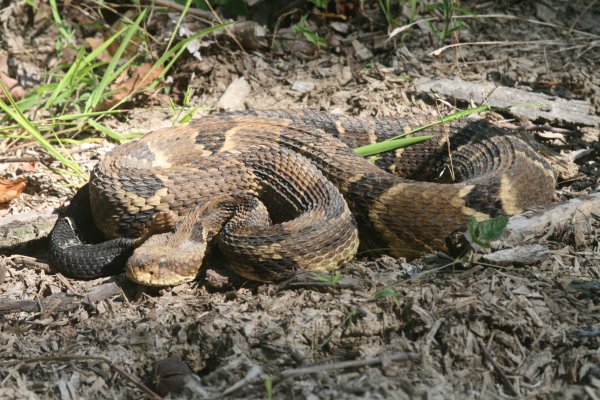 |
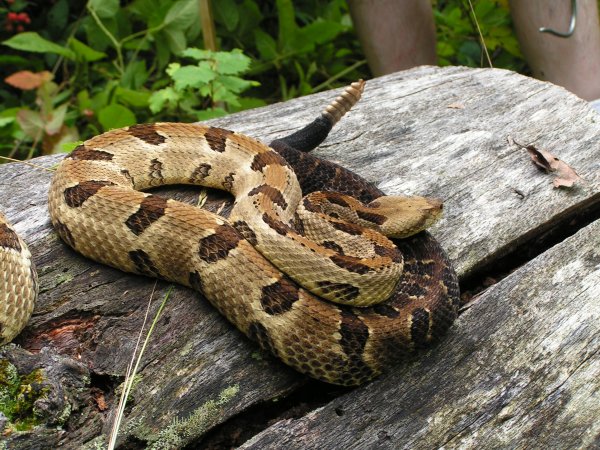 |
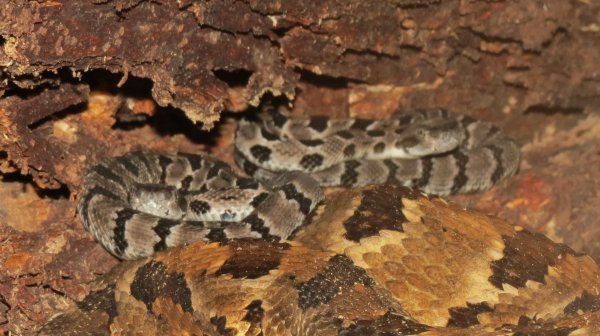 |
|













































































































































